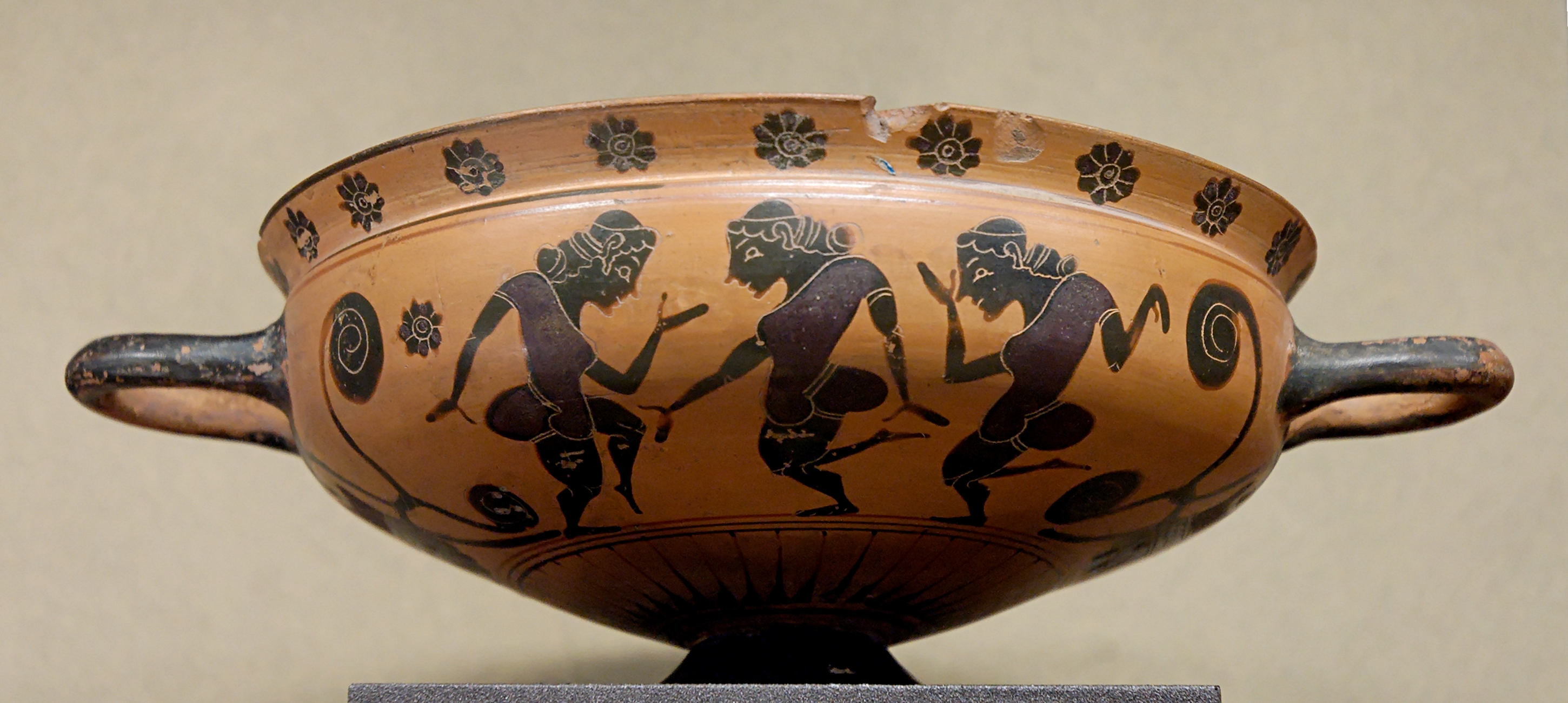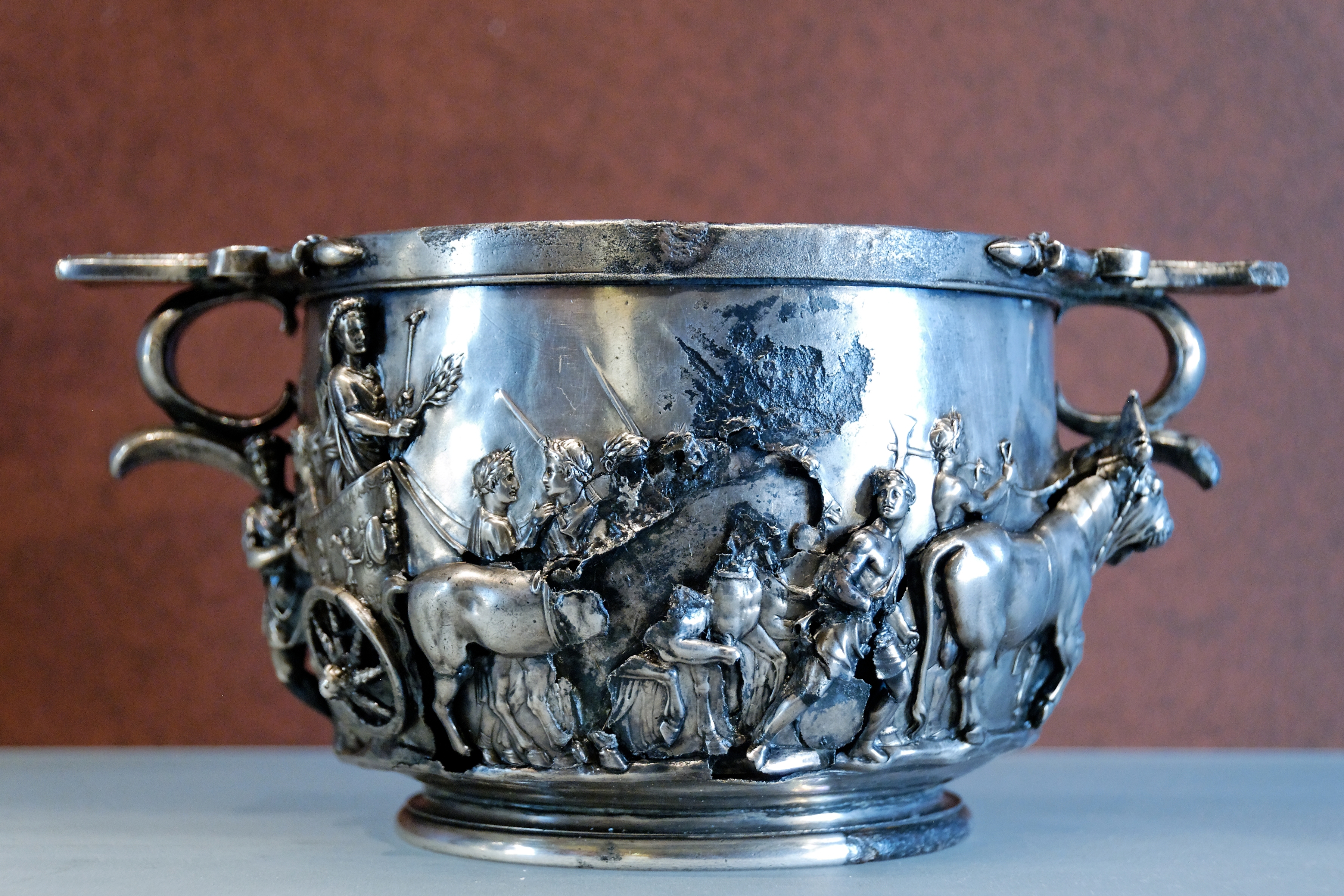|
KY Painter
The KY Painter was an Attic black-figure vase painter. He was active between 585 and 570 BC. Besides the KX Painter, the KY Painter was the main representative of the Komast Group, which succeeded the Gorgon Painter. His conventional name was allocated by John Beazley. He is considered the less talented and chronologically somewhat later representative of the group. Komasts are one of his favourite motifs. He mainly painted ''skyphoi'', '' lekanes'', '' kothones'' and Komast cups. He was the first artist to paint a column krater A krater or crater ( grc-gre, , ''kratēr'', literally "mixing vessel") was a large two-handled shape of vase in Ancient Greek pottery and metalwork, mostly used for the mixing of wine with water. Form and function At a Greek symposium, krat ..., which was to become a popular wine-mixing vessel. Bibliography * John D. Beazley: ''Attic Black-figure Vase-painters''. Oxford 1956, p. 31-33 * {{DEFAULTSORT:KY Painter Ancient Greek vase p ... [...More Info...] [...Related Items...] OR: [Wikipedia] [Google] [Baidu] |
Attica
Attica ( el, Αττική, Ancient Greek ''Attikḗ'' or , or ), or the Attic Peninsula, is a historical region that encompasses the city of Athens, the capital of Greece and its countryside. It is a peninsula projecting into the Aegean Sea, bordering on Boeotia to the north and Megaris to the west. The southern tip of the peninsula, known as Laurion, was an important mining region. The history of Attica is tightly linked with that of Athens, and specifically the Golden Age of Athens during the classical period. Ancient Attica ( Athens city-state) was divided into demoi or municipalities from the reform of Cleisthenes in 508/7 BC, grouped into three zones: urban (''astu'') in the region of Athens main city and Piraeus (port of Athens), coastal (''paralia'') along the coastline and inland (''mesogeia'') in the interior. The modern administrative region of Attica is more extensive than the historical region and includes Megaris as part of the regional unit West Attica, ... [...More Info...] [...Related Items...] OR: [Wikipedia] [Google] [Baidu] |
Black-figure Vase Painting
Black-figure pottery painting, also known as the black-figure style or black-figure ceramic ( grc, , }), is one of the styles of painting on antique Greek vases. It was especially common between the 7th and 5th centuries BCE, although there are specimens dating as late as the 2nd century BCE. Stylistically it can be distinguished from the preceding orientalizing period and the subsequent red-figure pottery style. Figures and ornaments were painted on the body of the vessel using shapes and colors reminiscent of silhouettes. Delicate contours were incised into the paint before firing, and details could be reinforced and highlighted with opaque colors, usually white and red. The principal centers for this style were initially the commercial hub Corinth, and later Athens. Other important production sites are known to have been in Laconia, Boeotia, eastern Greece, and Italy. Particularly in Italy individual styles developed which were at least in part intended for the Etruscan ... [...More Info...] [...Related Items...] OR: [Wikipedia] [Google] [Baidu] |
KX Painter
The KX Painter was an Attic black-figure vase painter. He was active between 585 and 570 BC. Besides the KY Painter, the KX Painter was the main representative of the Comast Group, which succeeded the Gorgon Painter. His conventional name was allocated by John Beazley. He is considered the better and chronologically somewhat earlier representative of the group. He was the first painter in Athens to occasionally depict komasts on his vases, a motif adopted from Corinthian vase painting. He mainly painted '' skyphoi'', '' lekanes'', '' kothones'' and Komast cups. In contrast to later representatives of the group, he still mostly painted animals, in a more careful and powerful style than the Gorgon Painter. Some mythological scenes by him are also known. Especially famous are his small-fornat mythical scenes placed within animal friezes. The KX Painter can be considered the first Attic painter to achieve a quality at par with that reached in Corinth, then the dominant centre of ... [...More Info...] [...Related Items...] OR: [Wikipedia] [Google] [Baidu] |
Comast Group
The Comast Group (also Komast Group) was a group of Attic vase painters in the black-figure style. The works of its members are dated to between 585 and 570/560 BC. The artists of the Komast Group are seen as the successors of the Gorgon Painter. Its most important representatives were the KX Painter and the slightly later KY Painter. They painted vases shapes that had been newly introduced to Athens or that had not previously been painted. Especially commonly painted by them were '’ kothon’’ and '' lekanis''. From Corinth, then still the centre of Greek vase painting, they adopted the Komast cup and the ''skyphos'' (known as '' kotyle''. The KY Painter introduced the column krater. Also popular at the time was the ''kantharos''. The group adopted the Corinthian habit of depicting komasts, after which the group is named. It provided the group’s most commonly painted motif. The komast scenes permit Attic artists for the first time to reach the artistic levels of middle-ra ... [...More Info...] [...Related Items...] OR: [Wikipedia] [Google] [Baidu] |
Gorgon Painter
The Gorgon Painter was one of the early Attic black-figure vase painters. He was active between 600 and 580 BC. His name vase, ''Dinos of the Gorgon Painter'', is currently on display in the Louvre and depicts Perseus fleeing the Gorgons. The Gorgon Painter is considered as a very productive successor of the Nessos Painter. Additionally, in accordance with other Geometric style artists, he arranged his subjects in symmetric patterns. Characteristic of his paintings are flat representations of humans or gods and animals painted in sections around the pottery. Rather than filling blank spaces with geometric patterns, the Gorgon Painter uses the Animal style; depicting real and fantastical animals in friezes around the vases which is considered to be a Corinthian tradition. The better recorded artist Sophilos is said to be influenced by the Gorgon Painter, continuing work in the black-figure style and zoomorphic decoration. Style Corinthian The Gorgon Painter is considered to ... [...More Info...] [...Related Items...] OR: [Wikipedia] [Google] [Baidu] |
John Beazley
Sir John Davidson Beazley, (; 13 September 1885 – 6 May 1970) was a British classical archaeologist and art historian, known for his classification of Attic vases by artistic style. He was Professor of Classical Archaeology and Art at the University of Oxford from 1925 to 1956. Early life Beazley was born in Glasgow, Scotland on 13 September 1885, to Mark John Murray Beazley (died 1940) and Mary Catherine Beazley née Davidson (died 1918). He was educated at King Edward VI School, Southampton and Christ's Hospital, Sussex. He then attended Balliol College, Oxford where he read Literae Humaniores: he received firsts in both Mods and Greats. He graduated with a Bachelor of Arts (BA) degree in 1907. While at Oxford he became a close friend of the poet James Elroy Flecker. Academic career After graduating, Beazley spent time at the British School at Athens. He then returned to University of Oxford as a student (equivalent to fellow) and tutor in Classics at Christ Church. ... [...More Info...] [...Related Items...] OR: [Wikipedia] [Google] [Baidu] |
Komos
The Kōmos ( grc, κῶμος; pl. kōmoi) was a ritualistic drunken procession performed by revelers in ancient Greece, whose participants were known as komasts (κωμασταί, ''kōmastaí''). Its precise nature has been difficult to reconstruct from the diverse literary sources and evidence derived from vase painting. The earliest reference to the komos is in Hesiod's '' Shield of Herakles'', which indicates it took place as part of wedding festivities (line 281). And famously Alcibiades gate-crashes the ''Symposium'' while carousing in a komos. However, no one kind of event is associated with the komos: Pindar describes them taking place at the city festivals (Pythian 5.21, 8.20, Olympian 4.9), while Demosthenes mentions them taking place after the '' ''pompe'''' and '' choregoi'' on the first day of the Greater Dionysia (Speeches 21.10), which may indicate the komos might have been a competitive event. The komos must be distinguished from the '' pompe'', or ritual pro ... [...More Info...] [...Related Items...] OR: [Wikipedia] [Google] [Baidu] |
Skyphos
A ''skyphos'' ( grc, σκύφος; plural ''skyphoi'') is a two-handled deep wine-cup on a low flanged base or none. The handles may be horizontal ear-shaped thumbholds that project from the rim (in both Corinthian and Athenian shapes), or they may be loop handles at the rim or that stand away from the lower part of the body. ''Skyphoi'' of the type called '' glaux'' (owl) have one horizontal and one vertical thumbhold handle. Examples Early ''skyphoi'' were made during the Geometric period. Corinth set the conventions that Athens followed. Over a long period the shape remained the same while the style of decoration changed. ''Skyphoi'' were also made of precious metals, generally silver and gold leaf, many examples exist. One possible, well-preserved example is the Warren cup,In his notes, John Pollini states that uncertainty about the correct name of many ancient drinking vessels exists, however he refers to the object with the "established classificatory term scyphus", Specif ... [...More Info...] [...Related Items...] OR: [Wikipedia] [Google] [Baidu] |
Komast Cup
The Komast cup (also Comast cup) is a cup shape at the beginning of the development of Attic drinking cups. Komast cups were widespread especially in Ionia and Corinth. Like other vase painters of the time, the Attic painters were under strong influence from Corinthian vase painting. The name is derived from the artists’ preferred theme, the ''komos'', a ritualistic drunken procession performed by revelers in ancient Greece, whose participants were known as komasts (κωμασταί, kōmastaí). This is a motif closely connected with Etruscan vase painting. The typical hemispherical shape with an angled "offset" lip and a low foot of only 1–2 cm height was an Attic development. The interior of the cups is black, only a narrow stripe or band below the lip is left in the base clay colour. The foot and the exterior of the handles are also black. The first specimens were quite large, but throughout the period of their production, the cups became gradually smaller. The mo ... [...More Info...] [...Related Items...] OR: [Wikipedia] [Google] [Baidu] |





